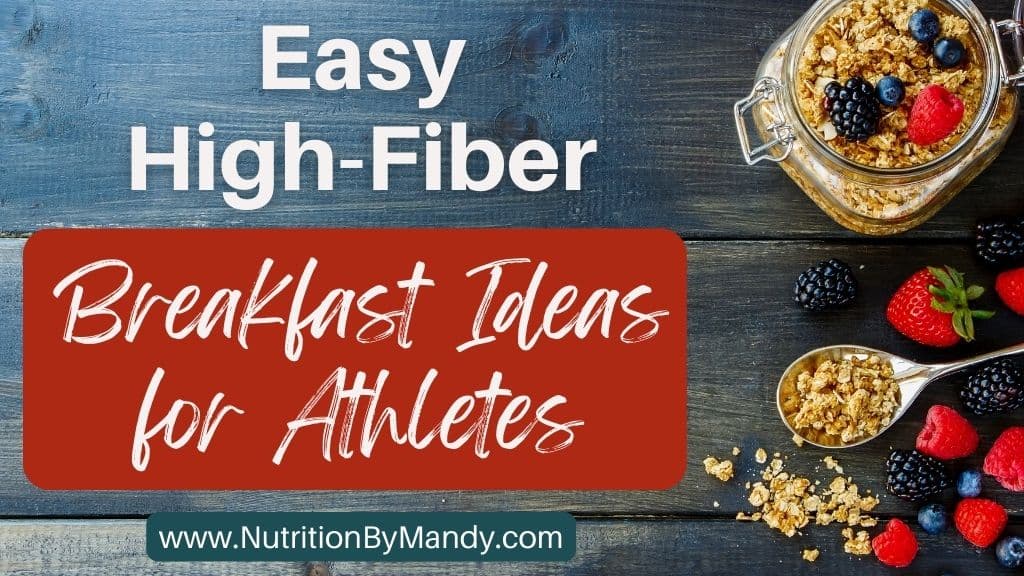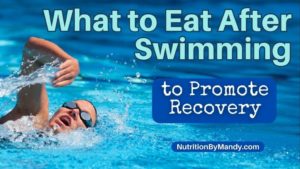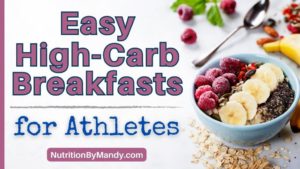15 Easy High-Fiber Breakfast Ideas for Athletes
Starting the day with a well-balanced, high-fiber breakfast is a nutritious way for athletes to begin the day.
Let’s take a look at what fiber is and the different types of dietary fiber. Then we will explore 15 easy high-fiber breakfast ideas for athletes.
What is Fiber?
Dietary fiber occurs naturally in plant foods, including fruits, vegetables, legumes, and whole grains.
Fiber is an important part of a well-balanced diet. Consuming an adequate amount of fiber in the diet is associated with many positive health benefits, including a reduced risk of developing many chronic diseases (1).
When discussing dietary fiber, it is classified into two types based on the fiber’s solubility in water. The The two types, soluble and insoluble fiber, function differently in the body providing different health benefits (1, 2).
Soluble Fiber
Soluble fiber dissolves in water forming a gel-like substance. In the body, soluble fiber helps to slow down the digestion process (1, 2).
Foods that contain soluble fiber include: whole grains, such as oats, barley, and rye, seeds, legumes, fruits, and vegetables.
Insoluble Fiber
Insoluble fiber does not dissolve in water. In the body, insoluble fiber helps speed up the passage of food through the intestine and adds bulk to stool (1, 2).
Insoluble fiber is found in vegetables, legumes, seeds, fruit (particularly the skin), wheat bran, brown rice, and whole grains.

How Much Fiber is Recommended?
The Institute of Medicine provides recommendations for adequate fiber intake that vary based upon both age and gender (3).
- Males
- 4-8 years old: 25 grams/day
- 9-13 years old: 31 grams/day
- 14-50 years old: 38 grams/day
- ≥ 51: 30 grams/day
- Females
- 4-8 years old: 25 grams/day
- 9-18 years old: 26 grams/day
- 19-50 years old: 25 grams/day
- ≥ 51: 21 grams/day
Despite the importance of dietary fiber, the majority of Americans do not consume the recommended amounts of fiber daily (1).
When it comes to athletes, many sports foods, such as shakes, gels, chews, and bars, tend to be low in fiber. Although sports foods serve an intended purpose surrounding activity, outside of activity it is important for athletes to plan nutritious meals that contain a variety of whole foods.
Ways to Add Fiber to an Athlete’s Breakfast
Let’s take a look at a variety of ways athletes can add fiber to their breakfast.
Oatmeal
Oatmeal is a whole grain carbohydrate containing soluble fiber. It also contains antioxidants, B Vitamins, phosphorus, magnesium, iron, copper, and zinc (4).
You can further increase the fiber and nutrient content of oatmeal by mixing in dried fruit, seeds, nuts, berries, and sliced bananas.

Overnight oats are a great breakfast food. They can be prepared the night before, saving you valuable time in the morning. You can increase the protein content by making them with Greek yogurt and ultra-filtered, high-protein milk.
Kodiak® PeakTM instant oatmeal packs are a great option for athletes looking a quick breakfast that provides both fiber and protein. I like stirring in nut butter and dried fruit for added nutrients.
High-Fiber Breakfast Cereals
Whole grain breakfast cereals are a great option for an easy high-fiber breakfast that requires little preparation.
When selecting a breakfast cereal, look at the nutrition facts label for a cereal that is made with whole grains and contain 20% or more of the Daily Value (DV) for fiber (5 grams or more per serving).
Some great high-fiber breakfast cereal options to keep in your pantry include:
- Kashi Go® Honey Almond Flax Crunch – Made with whole grains, flax seeds, and sliced almonds, this cereal makes a great substitute for granola. A ¾ cup serving provides 8 grams of fiber.
- Kellogg’s® Special K® Protein Cereal – Great cereal option to help you start the day with carbohydrates and protein. A 1 1/3 cup serving provides 5 grams of fiber.
- Quaker® Oatmeal Squares – A whole grain breakfast cereal that is delicious dry or with milk. A 1 cup serving provides 5 grams of fiber.
- Nature’s Path Organic Foods® Flax Plus® Raisin Bran Flakes – Whole grain cereal containing crunchy flakes, raisins, and flax seeds. A 1 1/4 cup serving provides 9 grams of fiber.
Many breakfast cereals are fortified with vitamins and minerals, which can help you meet your daily nutrient needs. To further boost the fiber and nutrient content of your breakfast cereal, add in dried fruit and nuts.

Whole Grain Bread
A great way to add fiber to breakfast is with whole grain bread items, including: bread, bagels, flatbread, tortillas, wraps, and English muffins.
When selecting whole grain breads, read the package to ensure the product is 100% whole grain. As you read the ingredient list, the word “whole” should be listed as the first ingredient in the product, such as whole wheat, whole oat, or whole rye.
Dave’s Killer Bread® has a wide variety of whole grain bread products including sandwich bread, breakfast bread, bagels, and English muffins.
If you have time on the weekend, you can meal prep whole grain pancakes or waffles to enjoy with breakfast throughout the week. The Organic 7 Grain Pancake & Waffle Mix from Bob’s Red Mill® is a great high-fiber option.
Carbohydrates provide the body with the energy needed to perform at its best. Having a high-carb breakfast with whole grain breads can help set you up for sports nutrition success.
Fruits and Vegetables
Fruits and vegetables are an excellent way to add fiber, vitamins, minerals, phytochemicals, and antioxidants to your morning meal.
Eating fruits and vegetables in their whole form will provide more fiber than when the food is processed. Juicing fruits and vegetables removes most of the fiber from the fresh produce.
Also keep in mind that the edible seeds of fruit (raspberries, kiwis) as well as skin of produce (apples, pears, peaches, potatoes) contain fiber. Thus, when looking to increase fiber intake you are better off eating the whole form.
Below are ideas for adding fruits and vegetables to your morning meal.

Avocados
Avocados are a great way to add fiber, healthy, unsaturated fats, vitamins, and minerals to your breakfast. A medium avocado provides ~14 grams of fiber (5), making it a healthy addition to an athlete’s meal plan.
At breakfast enjoy avocado as a topping on your toast, addition to your scrambled eggs, or even blended into a a healthy smoothie.
Leafy Greens
Leafy greens, such as spinach and kale, are packed full of nutrition, containing vitamins, minerals, antioxidants, and fiber.
Adding a handful of leafy greens to your morning smoothie is a great way to boost the nutrient content of your drink. Be aware that although the greens will not alter the taste of your smoothie, they will turn the smoothie a greenish-brown color.
At breakfast you can also add leafy greens to your omelet or breakfast burrito to increase the fiber and nutrient content of your meal.
Beans
Beans are a nutritious way to boost the fiber and protein content of your breakfast. Consider adding beans to a breakfast burrito, enjoying as a side dish with your meal, or having hummus as a spread with a breakfast wrap.
Dried Fruit
Dried fruit is another easy way to boost your fiber intake at breakfast. In addition to fiber, dried fruit contains phytochemicals, vitamins, and minerals (7).
Dried fruit, such as raisins, prunes, cranberries, pineapple, and mango, makes a nutritious addition to your oatmeal, breakfast cereal, and topping to your yogurt.
Seeds
Seeds are a nutrient-dense way to add fiber, unsaturated fat, protein, antioxidants, vitamins, and minerals to an athlete’s breakfast (8). Flaxseeds and chia seeds are two types of seeds that are extremely versatile and can easily be added into your morning oatmeal, smoothies, and yogurt.
Chia Seeds
Chia seeds contain ~10 grams of fiber per 1 oz (28 g) serving (8). A unique characteristic of chia seeds is their ability to absorb water. This makes chia seeds a great addition to smoothies and overnight oats.
In addition, chia seeds can be used at breakfast as a vegan egg substitute in baked goods or used to make chia seed pudding. Since chia seeds do not have much flavor, they provide an easy way to increase the fiber and nutrient content of your meal.

Flaxseeds
Flaxseeds are typically consumed ground, as it is easier for the body to digest and absorb the nutrients in the ground form. Ground flaxseeds contain ~6 grams of fiber per 1 oz (28 g) serving (9).
You can add ground flaxseeds into breakfast baked goods such as pancake, waffle, and muffin mixes. A tablespoon of ground flaxseeds can also be stirred into your bowl of breakfast cereal, to add fiber, protein, and omega-3 fatty acids to your meal.
15 High-Fiber Breakfast Ideas for Athletes
Putting this all together, here are 15 high-fiber breakfast ideas for athletes.
- Steel cut oatmeal with ground flaxseeds, raisins, and walnuts
- Greek yogurt with fresh mixed berries, chia seeds, and Kashi Go® Honey Almond Flax Crunch
- Breakfast burrito on a whole grain tortilla with scrambled eggs, spinach, sliced avocado, and black beans
- Baked Berry Oatmeal Bars*
- Avocado and egg toast on a whole grain bagel
- Breakfast bowl with quinoa, scrambled eggs, black beans, and sliced avocado
- Chia seed pudding* – topped with whole grain granola and blueberries
- Whole grain waffles topped with sliced banana and strawberries
- Smoothie bowl* – topped with dried fruit, nuts, seeds, berries, and sliced banana
High-Fiber Breakfast-On-The-Go Ideas
Even on busy mornings there are plenty of ways athletes can enjoy a high-fiber breakfast-on-the-go.
- Protein overnight oats with chia seeds, berries, and topped with whole grain granola for added crunch
- Whole grain breakfast bar, nut butter, banana
- Non-traditional breakfast wrap – turkey, hummus, sliced avocado, tomatoes, and spinach on a whole grain wrap
- Kodiak® PeakTM instant oatmeal with nut butter and dried fruit
- High-fiber smoothie* made with mixed berries, banana, chia seeds, and oats
- Breakfast trail mix – combine your favorite whole grain breakfast cereals, dried fruit, nuts, and seeds
* Recipes from Katie Dodd, Kathryn Pipe, and Jamie Nadeau, Registered Dietitian Nutritionists

Increasing Fiber Intake
If you are currently not eating enough fiber in your daily diet, slowly increase your intake to the recommended amounts. This allows your body to adjust to the increased intake and minimize any GI discomfort.
Also be mindful to ensure you are drinking plenty of water throughout the day, which helps your body with processing the increased fiber intake.
What About High-Fiber Breakfasts Before Morning Workouts?
Since fiber slows down digestion it is not recommended before exercise. Prior to a workout it is best to choose carbohydrates that are low in fiber and provide a quick source of energy (10).
Therefore, if you are going to be doing a morning workout, save the fiber-rich carbohydrates to enjoy with your breakfast after the exercise session.
Easy High-Fiber Breakfast Ideas for Athletes
You are now equipped with a variety of high-fiber breakfast ideas for athletes. Make sure to plan ahead to have a variety of high fiber breakfast foods available for the week. For additional tips on planning a healthy breakfast, check out my blog, 3 Keys to Building a Healthy Breakfast.
Join the Nutrition By Mandy Email List & Get a Free Athlete’s Grocery List
Click HERE to join the Nutrition By Mandy e-mail list. When you join you will receive a free athlete’s grocery list to print and take with you to the store.
About the Author
Mandy Tyler is a Sports Dietitian Nutritionist in the San Antonio, TX area. She is a Registered and Licensed Dietitian, a Board-Certified Specialist in Sports Dietetics, a Licensed Athletic Trainer, and is a Certified Exercise Physiologist through the American College of Sports Medicine. Mandy has experience working with athletes at the high school, collegiate, and professional levels. She believes the key to reaching one’s full potential, both in everyday life and in sports performance, relies on a healthy nutritional foundation.






